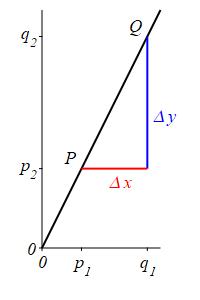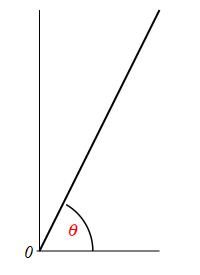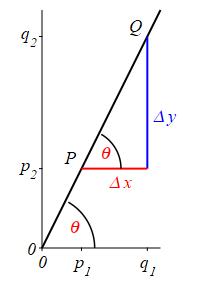3. Trigonometry
f. Applications of Trig Functions
3. Slope and Inclination
Two points determine a line. Let's consider the line through the points
\(P=(p_1,p_2)\) and \(Q=(q_1,q_2)\).
The rise is:
\[
\text{rise}=\Delta y=q_2-p_2
\]
The run is:
\[
\text{run}=\Delta x=q_1-p_1
\]
And the slope is:
\[
\text{slope}=m=\dfrac{\text{rise}}{\text{run}}
=\dfrac{\Delta y}{\Delta x}=\dfrac{q_2-p_2}{q_1-p_1}
\]

The inclination of a line is the angle \(\theta\) that the line makes with the positive \(x\) direction with the restriction that \(-\,\dfrac{\pi}{2} \le \theta \le \dfrac{\pi}{2}\).

The slope of a line is the tangent of its inclination \[ m=\tan\theta \]

Consider the line through the points \(P=(1,2)\) and \(Q=(4,-4)\). Find the slope, the inclination, the slope-intercept equation of the line and the \(y\)-intercept.
Recall the point-slope equation of the line: \(y=y_0+m(x-x_0)\).
\(m=-2\) \(\theta=-\arctan(2)\approx-1.107\)
\(y=-2x+4\) \(b=4\)
The slope is: \[ m=\dfrac{q_2-p_2}{q_1-p_1}=\dfrac{-4-2}{4-1}=\dfrac{-6}{3}=-2 \] The inclination is: \[ \theta=\arctan(m)=\arctan(-2)=-\arctan(2)\approx-1.107 \] We use the point-slope equation of the line to derive the slope-intercept equation: \[\begin{aligned} y&=p_2+m(x-p_1)=2-2(x-1) \\ &=-2x+4=mx+b \end{aligned}\] So the \(y\)-intercept is \(b=4\).
Consider the line through the points \(P=(2,5)\) with slope \(m=2\). Find the inclination, the slope-intercept equation of the line and the \(y\)-intercept.
\(\theta=\arctan(2)\approx1.107\)
\(y=-\arctan(2)x+2+\arctan(2)\) \(b=2+\arctan(2)\)
The inclination is: \[ \theta=\arctan(m)=\arctan(2)\approx1.107 \] We use the point-slope equation of the line to derive the slope-intercept equation: \[\begin{aligned} y&=p_2+m(x-p_1)=5+2(x-2) \\ &=2x+1=mx+b \end{aligned}\] So the \(y\)-intercept is \(b=1\).
Consider the line through the points \(P=(2,1)\) with inclination \(\theta=60^\circ\). Find the slope, the slope-intercept equation of the line and the \(y\)-intercept.
\(\begin{aligned} m&=\dfrac{\sqrt{3}}{2}\approx.866 \\ y&=\dfrac{\sqrt{3}}{2}x+1-\sqrt{3} \qquad\qquad b=1-\sqrt{3} \end{aligned}\)
The slope is: \[ m=\tan\theta=\tan60^\circ=\dfrac{\sqrt{3}}{2}\approx.866 \] We use the point-slope equation of the line to derive the slope-intercept equation: \[\begin{aligned} y&=p_2+m(x-p_1)=1+\dfrac{\sqrt{3}}{2}(x-2) \\ &=\dfrac{\sqrt{3}}{2}x+1-\sqrt{3}=mx+b \end{aligned}\] So the \(y\)-intercept is \(b=1-\sqrt{3}\).
Heading
Placeholder text: Lorem ipsum Lorem ipsum Lorem ipsum Lorem ipsum Lorem ipsum Lorem ipsum Lorem ipsum Lorem ipsum Lorem ipsum Lorem ipsum Lorem ipsum Lorem ipsum Lorem ipsum Lorem ipsum Lorem ipsum Lorem ipsum Lorem ipsum Lorem ipsum Lorem ipsum Lorem ipsum Lorem ipsum Lorem ipsum Lorem ipsum Lorem ipsum Lorem ipsum